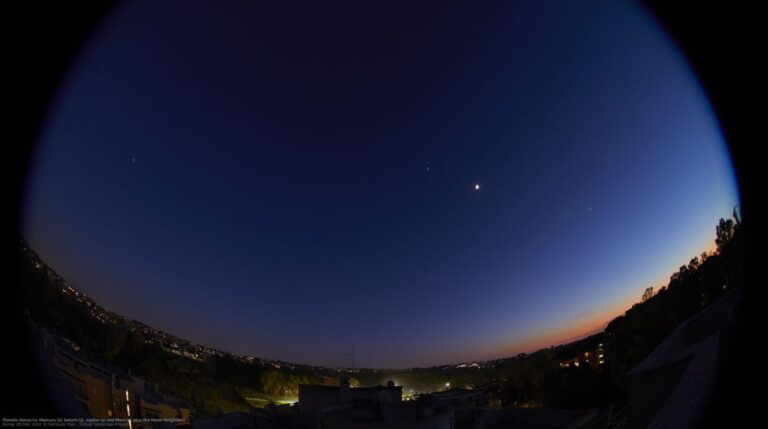
[ad_1]
After days of clouds in Rome, the skies finally cleared for a “planet parade.”
Virtual Telescope Project founder Gianluca Masi was at the ready with telescopes, cameras and broadcasting equipment to observe the five naked-eye planets on Wednesday evening (Dec. 28). The most-easily seen planets were Mercury, Venus, Mars, Jupiter and Saturn. He also spotted Uranus and Neptune, which require equipment to view.
“A very beautiful Christmas present from the sky,” Masi wrote (opens in new tab) of the celestial sight. “I managed to capture some great images and share the view with the world.”
If you’re looking for binoculars or a telescope to see the solar system planets, our guides for the best binoculars and the best telescopes have options that can help. If you need photography gear, consider our best cameras for astrophotography and best lenses for astrophotography to prepare for the next planet sight.
Masi caught the five planets in a single view using a panoramic “fish-eye” lens, which gives a 180-degree field of view of the sky. He also set up several zoom lenses on a telescope mounted on the roof of his house in Rome.
Fleeting Mercury was the greatest challenge as it is fast fading from view in a bright twilight sky, but Masi managed to just capture it in the fish-eye lens. Zooming was easier, he said, “as I could select the best camera/lens settings for each planet.”
Masi captured Venus and Mercury together, “showing in such a colorful sky just above the S-W (southwest) horizon.” Then he proceeded through the sky, capturing each of the planets in turn and even imaging the remaining two only visible in telescope or high-powered binoculars: Uranus and Neptune. You can see the entire “parade” in the gallery above.
“I’m already looking forward to the next cosmic show to bring to our community,” Masi said; his next broadcast will be previewing the Quadrantid meteor shower that peaks on Jan. 4, unfortunately during a very bright and nearly full moon. But if you miss it, there will be other meteor showers in 2023 sure to produce amazing shooting stars.
Elizabeth Howell is the co-author of “Why Am I Taller (opens in new tab)?” (ECW Press, 2022; with Canadian astronaut Dave Williams), a book about space medicine. Follow her on Twitter @howellspace (opens in new tab). Follow us on Twitter @Spacedotcom (opens in new tab) or Facebook (opens in new tab).
[ad_2]
